Effect of Pond-Based Rice Floating Bed on the Microbial Community Structure and Quality of Water in Pond of Mandarin Fish Fed Using Artificial Diet
Abstract
:Simple Summary
Abstract
1. Introduction
2. Materials and Methods
2.1. Experimental Design
2.2. Sampling
2.3. Method for Water Quality Measurement
2.4. Illumina High-Throughput Sequencing
2.5. Data Processing and Statistical Analysis
3. Results
3.1. Analysis of Water Quality Parameters
3.2. Analysis of Illumina High-Throughput Sequencing Results
3.2.1. α-Diversity Analysis
3.2.2. β-Diversity Analysis
3.3. Spearman Correlation Analysis between Water Quality Parameters and Microbial Communities at the Genus Level
3.4. Analysis of Microbial Community Composition
3.5. Analysis of Differential Bacterial Genera
3.6. The Correlation Network Analysis
3.7. Function Analysis
4. Discussion
5. Conclusions
Supplementary Materials
Author Contributions
Funding
Institutional Review Board Statement
Informed Consent Statement
Data Availability Statement
Conflicts of Interest
References
- China Society of Fisheries. China Fishery Statistical Yearbook; China Agriculture Press: Beijing, China, 2023. (In Chinese) [Google Scholar]
- Niu, S.H.; Li, H.Y.; Pan, H.J.; Xie, J.; Wang, G.J.; Xia, Y.; Gong, W.B. Effects of live prey fish and artificial diet on nutrient compositions and texture properties in the muscle of mandarin fish (Siniperca chuatsi). Acta Hydrob. Sin. 2023, 47, 37–44. (In Chinese) [Google Scholar] [CrossRef]
- Li, Y.; Li, J.; Lu, J.; Li, Z.; Shi, S.; Liu, Z. Effects of live and artificial feeds on the growth, digestion, immunity and intestinal microflora of mandarin fish hybrid (Siniperca chuatsi♀ × Siniperca scherzeri♂). Aquac. Res. 2017, 48, 4479–4485. [Google Scholar] [CrossRef]
- Gao, Y.A.; Xia, X.P.; Zhu, S.H. Appropriate water quality and management measures for main cultivation of mandarin fish ponds. Cur. Fish. 2000, 25, 29–30. (In Chinese) [Google Scholar]
- Cao, X.; Li, J.J. Ecological and high-profit intensive culture technique for mandarin fish in pond. Sci. Fish Farm. 2021, 05, 44–46. (In Chinese) [Google Scholar] [CrossRef]
- Huang, L.; Zhuo, J.; Guo, W.; Spencer, R.G.; Zhang, Z.; Xu, J. Tracing organic matter removal in polluted coastal waters via floating bed phytoremediation. Mar. Pollut. Bull. 2013, 71, 74–82. [Google Scholar] [CrossRef]
- Li, W.; Li, Z. In situ nutrient removal from aquaculture wastewater by aquatic vegetable Ipomoea aquatica on floating beds. Water Sci. Technol. 2009, 59, 1937–1943. [Google Scholar] [CrossRef]
- Cao, W.; Zhang, Y. Removal of nitrogen (N) from hypereutrophic waters by ecological floating beds (EFBs) with various substrates. Ecol. Eng. 2014, 62, 148–152. [Google Scholar] [CrossRef]
- Younas, A.; Kumar, L.; Deitch, M.J.; Qureshi, S.S.; Shafiq, J.; Ali Naqvi, S.; Kumar, A.; Amjad, A.Q.; Nizamuddin, S. Treatment of industrial wastewater in a floating treatment wetland: A case study of Sialkot Tannery. Sustainability 2022, 14, 12854. [Google Scholar] [CrossRef]
- Huett, D.; Morris, S.; Smith, G.; Hunt, N. Nitrogen and phosphorus removal from plant nursery runoff in vegetated and unvegetated subsurface flow wetlands. Water Res. 2005, 39, 3259–3272. [Google Scholar] [CrossRef]
- Abed, S.N.; Almuktar, S.A.; Scholz, M. Remediation of synthetic greywater in mesocosm—Scale floating treatment wetlands. Ecol. Eng. 2017, 102, 303–319. [Google Scholar] [CrossRef]
- Frei, M.; Becker, K. A greenhouse experiment on growth and yield effects in integrated rice–fish culture. Aquaculture 2005, 244, 119–128. [Google Scholar] [CrossRef]
- Bello, U.; Girei, I.; Maradun, H.; Bukar, A. Comparative study of two varieties of rice (FARO 44 and FARO 60) on growth performance of African catfish (Clarias gariepinus) in fish cum rice integrated system. Int. J. Fish. Aquat. Stud. 2020, 8, 261–264. [Google Scholar]
- Li, F.; Sun, Z.; Qi, H.; Zhou, X.; Xu, C.; Wu, D.; Fang, F.; Feng, J.; Zhang, N. Effects of rice-fish co-culture on oxygen consumption in intensive aquaculture pond. Rice Sci. 2019, 26, 50–59. [Google Scholar] [CrossRef]
- Mohanty, R.K.; Verma, H.; Brahmanand, P. Performance evaluation of rice–fish integration system in rainfed medium land ecosystem. Aquaculture 2004, 230, 125–135. [Google Scholar] [CrossRef]
- Tarigan, N.B.; Goddek, S.; Keesman, K.J. Explorative study of aquaponics systems in Indonesia. Sustainability 2021, 13, 12685. [Google Scholar] [CrossRef]
- Hu, L.; Zhang, J.; Ren, W.; Guo, L.; Cheng, Y.; Li, J.; Li, K.; Zhu, Z.; Zhang, J.; Luo, S.; et al. Can the co-cultivation of rice and fish help sustain rice production? Sci. Rep. 2016, 6, 28728. [Google Scholar] [CrossRef]
- Goda, A.M.S.; Aboseif, A.M.; Mohammedy, E.Y.; Taha, M.K.; Mansour, A.I.; Ramadan, E.A.; Aboushabana, N.M.; Zaher, M.M.; Otazua, N.I.; Ashour, M. Earthen pond-based floating beds for rice-fish co-culture as a novel concept for climate adaptation, water efficiency improvement, nitrogen and phosphorus management. Aquaculture 2024, 579, 740215. [Google Scholar] [CrossRef]
- Zhu, J.; Wei, R.; Wang, X.; Jiang, X.; Wang, M.; Yang, Y.; Yang, L. The ppk-expressing transgenic rice floating bed improves P removal in slightly polluted water. Environ. Res. 2023, 231, 116261. [Google Scholar] [CrossRef]
- Ahmed, N.; Hornbuckle, J.; Turchini, G.M. Blue–green water utilization in rice–fish cultivation towards sustainable food production. Ambio 2022, 51, 1933–1948. [Google Scholar] [CrossRef]
- Somerville, C.; Cohen, M.; Pantanella, E.; Stankus, A.; Lovatelli, A. Small-Scale Aquaponic Food Production: Integrated Fish and Plant Farming; FAO Fisheries and Aquaculture Technical Paper 598; Food and Agriculture Organization of the United Nations: Rome, Italy, 2014. [Google Scholar]
- Wang, W.H.; Wang, Y.; Sun, L.Q.; Zheng, Y.C.; Zhao, J.C. Research and application status of ecological floating bed in eutrophic landscape water restoration. Sci. Total Environ. 2020, 704, 135434. [Google Scholar] [CrossRef]
- Feng, J.; Li, F.; Zhou, X.; Xu, C.; Fang, F. Nutrient removal ability and economical benefit of a rice-fish co-culture system in aquaculture pond. Ecol. Eng. 2016, 94, 315–319. [Google Scholar] [CrossRef]
- Li, F.; Feng, J.; Zhou, X.; Liu, Y.; Xu, C.; Ji, L.; Chen, Z.; Jijakli, M.H.; Fang, F.; Zhang, W. Effect of rice-fish/shrimp co-culture on sediment resuspension and associated nutrients release in intensive aquaculture ponds. Arch. Agron. Soil Sci. 2020, 66, 971–982. [Google Scholar] [CrossRef]
- Yoneyama, T.; Matsumaru, T.; Usui, K.; Engelaar, W. Discrimination of nitrogen isotopes during absorption of ammonium and nitrate at different nitrogen concentrations by rice (Oryza sativa L.) plants. Plant Cell Environ. 2001, 24, 133–139. [Google Scholar] [CrossRef]
- Hayashi, K.; Nishimura, S.; Yagi, K. Ammonia volatilization from a paddy field following applications of urea: Rice plants are both an absorber and an emitter for atmospheric ammonia. Sci. Total Environ. 2008, 390, 485–494. [Google Scholar] [CrossRef]
- Delhaize, E.; Ryan, P.R. Aluminum toxicity and tolerance in plants. Plant Physiol. 1995, 107, 315. [Google Scholar] [CrossRef]
- Ma, T.; Luo, G.Z.; Tan, H.X.; Chen, W. Effect of Alkalinity on nitrogen conversion and biological characteriztion of bioflcs process in aquaculture. Fish. Sci. 2017, 36, 421–428. (In Chinese) [Google Scholar] [CrossRef]
- Sun, Y.; Zeng, J.N.; Wu, Y.L. Study on the relationship between basicity and NH3-N in a wastewater treament system. Technol. Water Treat. 2022, 48, 114–117. (In Chinese) [Google Scholar] [CrossRef]
- Amon, J.; Titgemeyer, F.; Burkovski, A. A genomic view on nitrogen metabolism and nitrogen control in mycobacteria. Microb. Physiol. 2009, 17, 20–29. [Google Scholar] [CrossRef]
- Tan, X.; Yang, Y.L.; Liu, Y.W.; Li, X.; Zhu, W.B. Quantitative ecology associations between heterotrophic nitrification-aerobic denitrification, nitrogen-metabolism genes, and key bacteria in a tidal flow constructed wetland. Bioresour. Technol. 2021, 337, 125449. [Google Scholar] [CrossRef] [PubMed]
- Sagar, A.; Rai, S.; Ilyas, N.; Sayyed, R.; Al-Turki, A.I.; El Enshasy, H.A.; Simarmata, T. Halotolerant rhizobacteria for salinity-stress mitigation: Diversity, mechanisms and molecular approaches. Sustainability 2022, 14, 490. [Google Scholar] [CrossRef]
- Liu, Y.; Ma, B.; Liu, Z. Application of a partial nitrogen lab-scale sequencing batch reactor for the treatment of organic wastewater and its N2O production pathways, and the microbial mechanism. Sustainability 2022, 14, 1457. [Google Scholar] [CrossRef]
- Zhu, S.; Deng, J.; Jin, X.; Wu, H.; Wei, C.; Qiu, G.; Preis, S.; Wei, C. Diverse and distinct bacterial community involved in a full-scale A/O1/H/O2 combination of bioreactors with simultaneous decarbonation and denitrogenation of coking wastewater. Environ. Sci. Pollut. Res. 2023, 30, 2103–2117. [Google Scholar] [CrossRef] [PubMed]
- Pan, H.; Cui, M.H.; Zhang, C.; Liu, L.Y.; Li, J.; Jiang, Q.; Zhang, X.D.; Zheng, Z.Y.; Zhang, Y.; Liu, H. Alkalinity regulation in a sulfur autotrophic denitrifying filter substantially reduced total dissolved solids and sulfate in effluent. Bioresour. Technol. 2022, 348, 126751. [Google Scholar] [CrossRef] [PubMed]
- Su, J.; Yang, S.; Huang, T.; Li, M.; Liu, J.; Yao, Y. Enhancement of the denitrification in low C/N condition and its mechanism by a novel isolated Comamonas sp. YSF15. Environ. Pollut. 2020, 256, 113294. [Google Scholar] [CrossRef] [PubMed]
- Zheng, Y.; Chai, L.; Yang, Z.; Chen, Y.; Shi, Y.; Wang, Y. Environmentally safe treatment of black liquor with Comamonas sp. B-9 under high-alkaline conditions. J. Basic Microbiol. 2014, 54, 152–161. [Google Scholar] [CrossRef] [PubMed]
- Arunrat, N.; Sansupa, C.; Kongsurakan, P.; Sereenonchai, S.; Hatano, R. Soil microbial diversity and community composition in rice–fish co-culture and rice monoculture farming system. Biology 2022, 11, 1242. [Google Scholar] [CrossRef] [PubMed]
- Herlambang, A.; Murwantoko, M.; Istiqomah, I. Dynamic change in bacterial communities in the integrated rice–fish farming system in Sleman, Yogyakarta, Indonesia. Aquac. Res. 2021, 52, 5566–5578. [Google Scholar] [CrossRef]
- Zhang, Y.; Chen, M.; Zhao, Y.Y.; Zhang, A.Y.; Peng, D.H.; Lu, F.; Dai, C.C. Destruction of the soil microbial ecological environment caused by the over-utilization of the rice-crayfish co-cropping pattern. Sci. Total Environ. 2021, 788, 147794. [Google Scholar] [CrossRef]
- Liu, Z.; Iqbal, M.; Zeng, Z.; Lian, Y.; Zheng, A.; Zhao, M.; Li, Z.; Wang, G.; Li, Z.; Xie, J. Comparative analysis of microbial community structure in the ponds with different aquaculture model and fish by high-throughput sequencing. Microb. Pathog. 2020, 142, 104101. [Google Scholar] [CrossRef]
- Zhang, C.; Mi, W.; Xu, Y.; Zhou, W.; Bi, Y. Long-term integrated rice-crayfish culture disrupts the microbial communities in paddy soil. Aquac. Rep. 2023, 29, 101515. [Google Scholar] [CrossRef]
- Aislabie, J.; Deslippe, J.R.; Dymond, J. Soil microbes and their contribution to soil services. In Ecosystem Services in New Zealand–Conditions and Trends; Manaaki Whenua Press: Lincoln, New Zealand, 2013; Volume 1, pp. 143–161. [Google Scholar]
- Kim, M.K.; Jung, H.Y. Chitinophaga terrae sp. nov., isolated from soil. Int. J. Syst. Evol. Microbiol. 2007, 57, 1721–1724. [Google Scholar] [CrossRef] [PubMed]
- Crofts, A.R. Photosynthesis in Rhodobacter sphaeroides. Trends Microbiol. 2000, 8, 105–106. [Google Scholar] [CrossRef] [PubMed]
- Imhoff, J.F. Rhodobacter. In Bergey’s Manual of Systematics of Archaea and Bacteria; John Wiley & Sons, Inc.: Hoboken, NJ, USA, 2015; pp. 1–12. [Google Scholar] [CrossRef]
- Koku, H.; Eroğlu, İ.; Gündüz, U.; Yücel, M.; Türker, L. Aspects of the metabolism of hydrogen production by Rhodobacter sphaeroides. Int. J. Hydrogen Energy 2002, 27, 1315–1329. [Google Scholar] [CrossRef]
- Ishiyama, Y.; Ogiso, H.; Furuta, G. Corky root of lettuce caused by Rhizorhapis suberifaciens in Japan. J. Gen. Plant Pathol. 2022, 88, 150–154. [Google Scholar] [CrossRef]
- Fischer, H.M. Genetic regulation of nitrogen fixation in rhizobia. Microbiol. Rev. 1994, 58, 352–386. [Google Scholar] [CrossRef]
- Zahran, H.H. Rhizobium-legume symbiosis and nitrogen fixation under severe conditions and in an arid climate. Microbiol. Mol. Biol. Rev. 1999, 63, 968–989. [Google Scholar] [CrossRef]
- Dai, L.; Liu, C.; Peng, L.; Song, C.; Li, X.; Tao, L.; Li, G. Different distribution patterns of microorganisms between aquaculture pond sediment and water. J. Microbiol. 2021, 59, 376–388. [Google Scholar] [CrossRef] [PubMed]
- Gao, Y.; Zhang, Y.; Wei, Q.; Qi, X.; Yin, Q.; Liu, B.; He, K. Response and synergistic effect of microbial community to submerged macrophyte in restoring urban black and smelly water bodies. J. Water Process. Eng. 2023, 53, 103906. [Google Scholar] [CrossRef]
- Lin, W.; Fan, F.; Xu, G.; Gong, K.; Cheng, X.; Yuan, X.; Zhang, C.; Gao, Y.; Wang, S.; Ng, H.Y.; et al. Microbial community assembly responses to polycyclic aromatic hydrocarbon contamination across water and sediment habitats in the Pearl river estuary. J. Hazard. Mater. 2023, 457, 131762. [Google Scholar] [CrossRef]
- Guo, J.; Dou, W.; Liu, Z.; Sun, J.; Xu, D.; Yang, Q.; Lv, G.; Wang, D. Long-term heavy metal pollution induces complex differences in farmland topsoil and rhizosphere microbial communities. Sustainability 2023, 15, 16598. [Google Scholar] [CrossRef]
- Li, N.; Chen, X.; Zhao, H.; Tang, J.; Jiang, G.; Li, Z.; Li, X.; Chen, S.I.; Zou, S.; Dong, K.; et al. Spatial distribution and functional profile of the bacterial community in response to eutrophication in the subtropical Beibu Gulf, China. Mar. Pollut. Bull. 2020, 161, 111742. [Google Scholar] [CrossRef]
- Gómez-Consarnau, L.; Lindh, M.V.; Gasol, J.M.; Pinhassi, J. Structuring of bacterioplankton communities by specific dissolved organic carbon compounds. Environ. Microbiol. 2012, 14, 2361–2378. [Google Scholar] [CrossRef] [PubMed]
- Wang, Y.; Du, L.; Liu, H.; Long, D.; Huang, M.; Wang, Y.; Huang, S.; Jin, D. Halosulfuron methyl did not have a significant effect on diversity and community of sugarcane rhizosphere microflora. J. Hazard. Mater. 2020, 399, 123040. [Google Scholar] [CrossRef] [PubMed]
- Sorokin, D.Y.; Lücker, S.; Vejmelkova, D.; Kostrikina, N.A.; Kleerebezem, R.; Rijpstra, W.I.C.; Damsté, J.S.S.; Le Paslier, D.; Muyzer, G.; Wagner, M.; et al. Nitrification expanded: Discovery, physiology and genomics of a nitrite-oxidizing bacterium from the phylum Chloroflexi. ISME J. 2012, 6, 2245–2256. [Google Scholar] [CrossRef] [PubMed]
- Shen, M.C.; Zhang, Y.Z.; Bo, G.D.; Yang, B.; Wang, P.; Ding, Z.Y.; Wang, Z.B.; Yang, J.M.; Zhang, P.; Yuan, X.L. Microbial responses to the reduction of chemical fertilizers in the rhizosphere soil of flue-cured tobacco. Front. Bioeng. Biotechnol. 2022, 9, 812316. [Google Scholar] [CrossRef] [PubMed]
- Zhang, B.; Li, Z.L.; Bai, C.H.; Liu, J.L.; Nan, J.; Cao, D.; Li, L.W. Characteristics of groundwater microbial communities’ structure under the impact of elevated nitrate concentrations in north China plain. Environ. Res. 2023, 218, 115003. [Google Scholar] [CrossRef]
- Liu, G.; Ma, P.; Cheng, Z.; Wang, Y.; Li, Y.; Wu, X. Effects of thaw slump on soil bacterial communities on the Qinghai-Tibet Plateau. Catena 2023, 232, 107342. [Google Scholar] [CrossRef]
- Xu, Z.; Te, S.H.; He, Y.; Gin, K.Y.H. The characteristics and dynamics of cyanobacteria–heterotrophic bacteria between two estuarine reservoirs–tropical versus sub-tropical regions. Front. Microbiol. 2018, 9, 2531. [Google Scholar] [CrossRef] [PubMed]
- Zwart, G.; Huismans, R.; van Agterveld, M.P.; Van de Peer, Y.; De Rijk, P.; Eenhoorn, H.; Muyzer, G.; van Hannen, E.J.; Gons, H.J.; Laanbroek, H.J. Divergent members of the bacterial division Verrucomicrobiales in a temperate freshwater lake. FEMS Microbiol. Ecol. 1998, 25, 159–169. [Google Scholar] [CrossRef]
- Mohapatra, M.; Behera, P.; Kim, J.Y.; Rastogi, G. Seasonal and spatial dynamics of bacterioplankton communities in a brackish water coastal lagoon. Sci. Total Environ. 2020, 705, 134729. [Google Scholar] [CrossRef]
- Pindi, P.K.; Ashwitha, K.; Rani, A.S. Chryseomicrobium palamuruense sp. nov., a haloalkalitolerant bacterium isolated from a sediment sample. Int. J. Syst. Evol. Microbiol. 2016, 66, 3731–3736. [Google Scholar] [CrossRef] [PubMed]
- Wu, H.; Zhang, Q.; Chen, X.; Zhu, Y.; Yuan, C.; Zhang, C. The influence mechanism of DO on the microbial community and carbon source metabolism in two solid carbon source systems. Environ. Res. 2022, 206, 112410. [Google Scholar] [CrossRef] [PubMed]
- Shahid, M.J.; AL-surhanee, A.A.; Kouadri, F.; Ali, S.; Nawaz, N.; Afzal, M.; Rizwan, M.; Ali, B.; Soliman, M.H. Role of microorganisms in the remediation of wastewater in floating treatment wetlands: A review. Sustainability 2020, 12, 5559. [Google Scholar] [CrossRef]
- Li, P.; Wang, C.; Liu, G.; Luo, X.; Rauan, A.; Zhang, C.; Li, T.; Yu, H.; Dong, S.; Gao, Q. A hydroponic plants and biofilm combined treatment system efficiently purified wastewater from cold flowing water aquaculture. Sci. Total Environ. 2022, 821, 153534. [Google Scholar] [CrossRef] [PubMed]
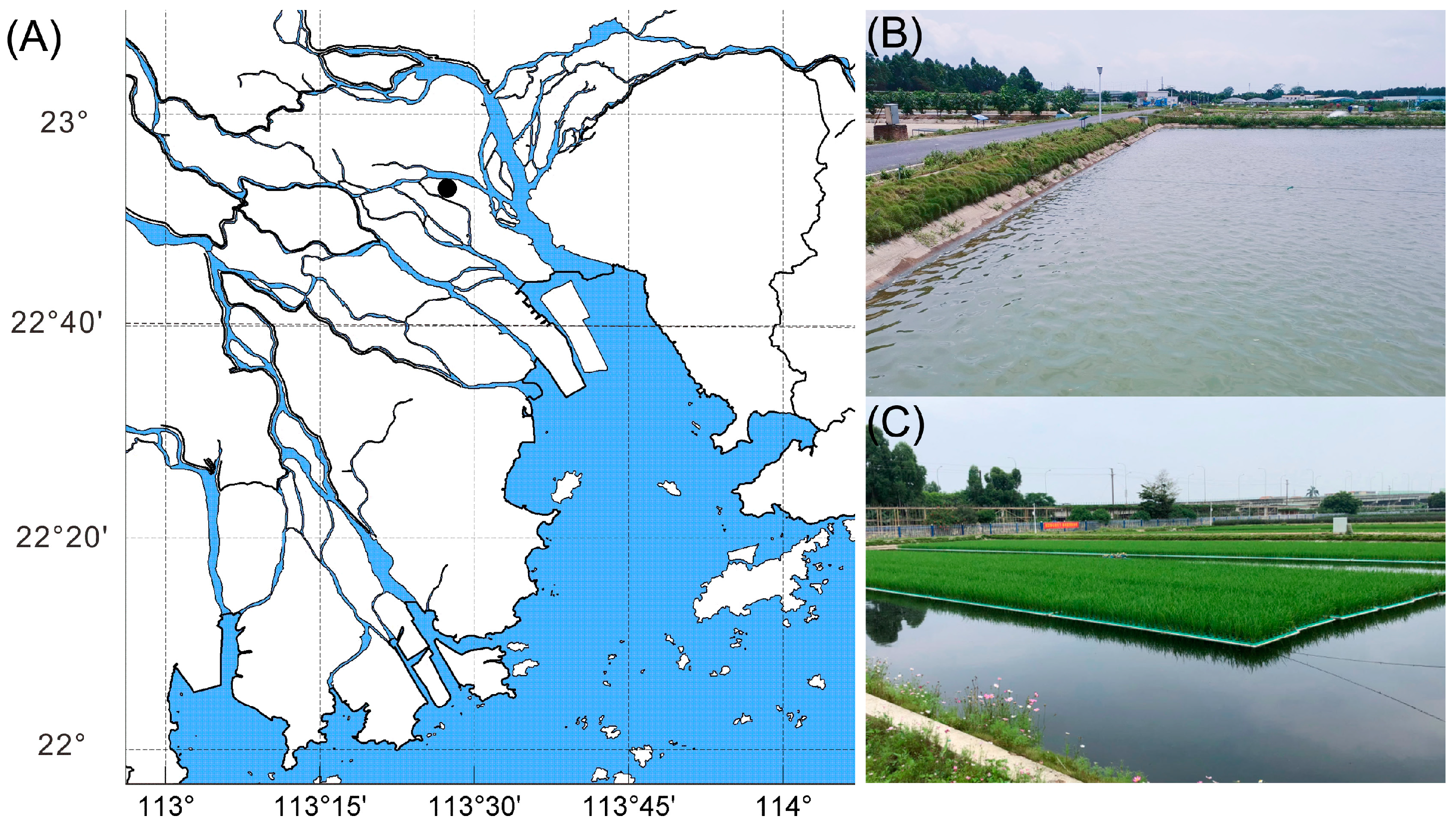
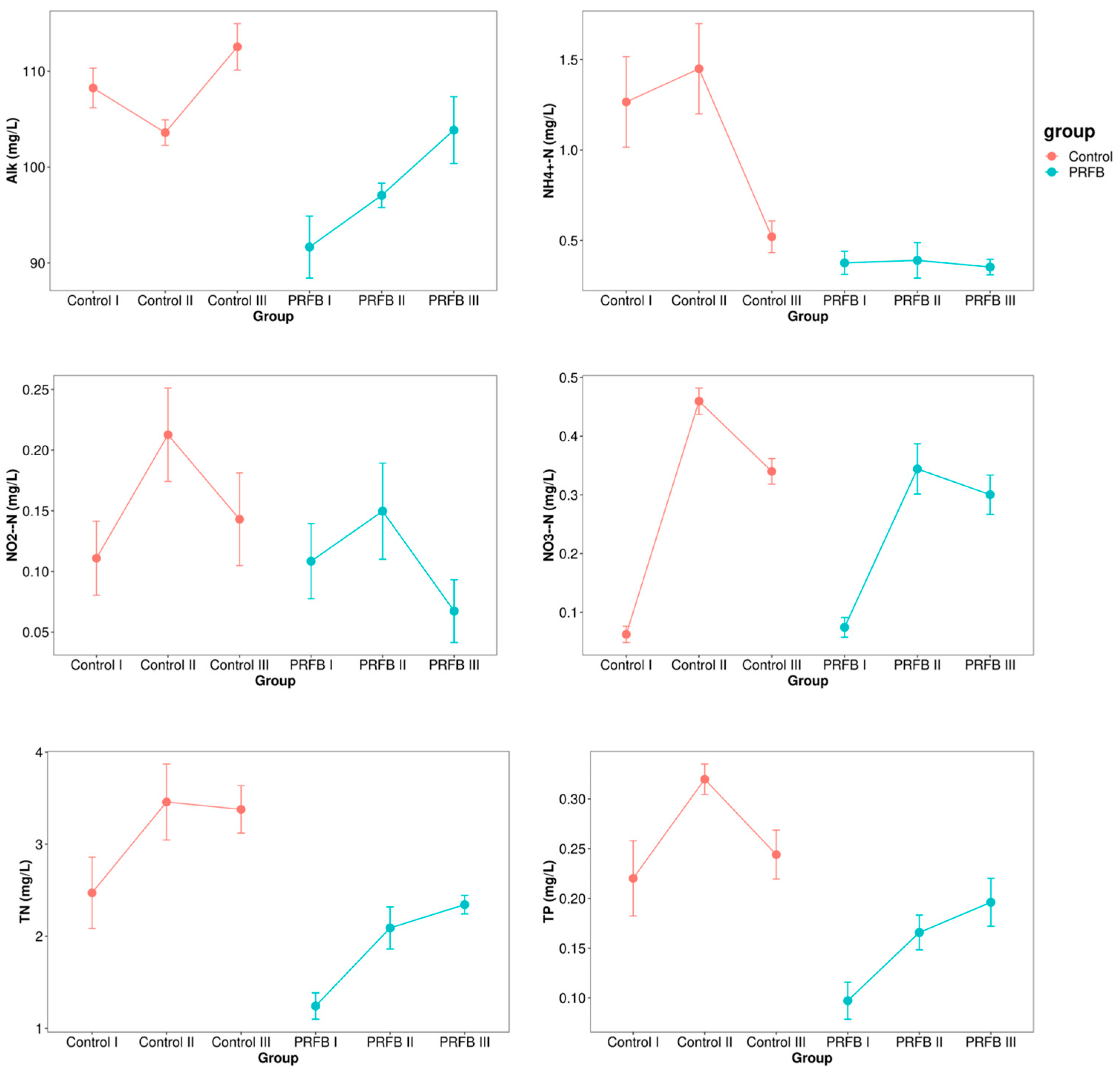
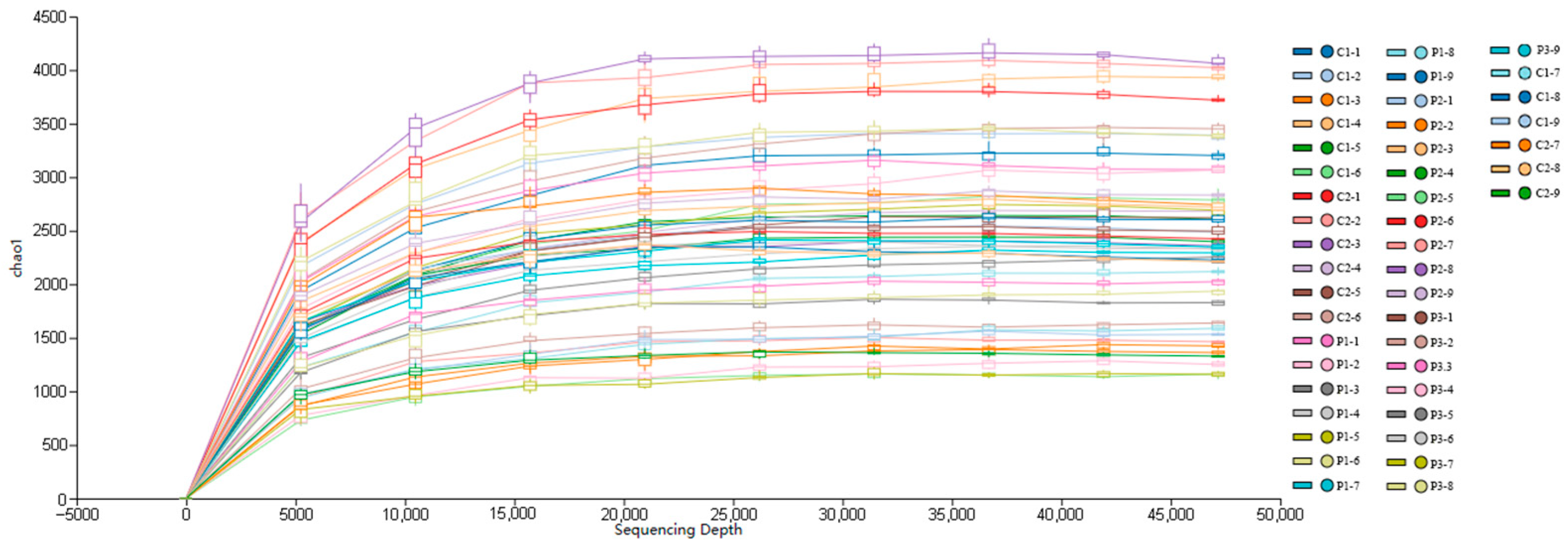
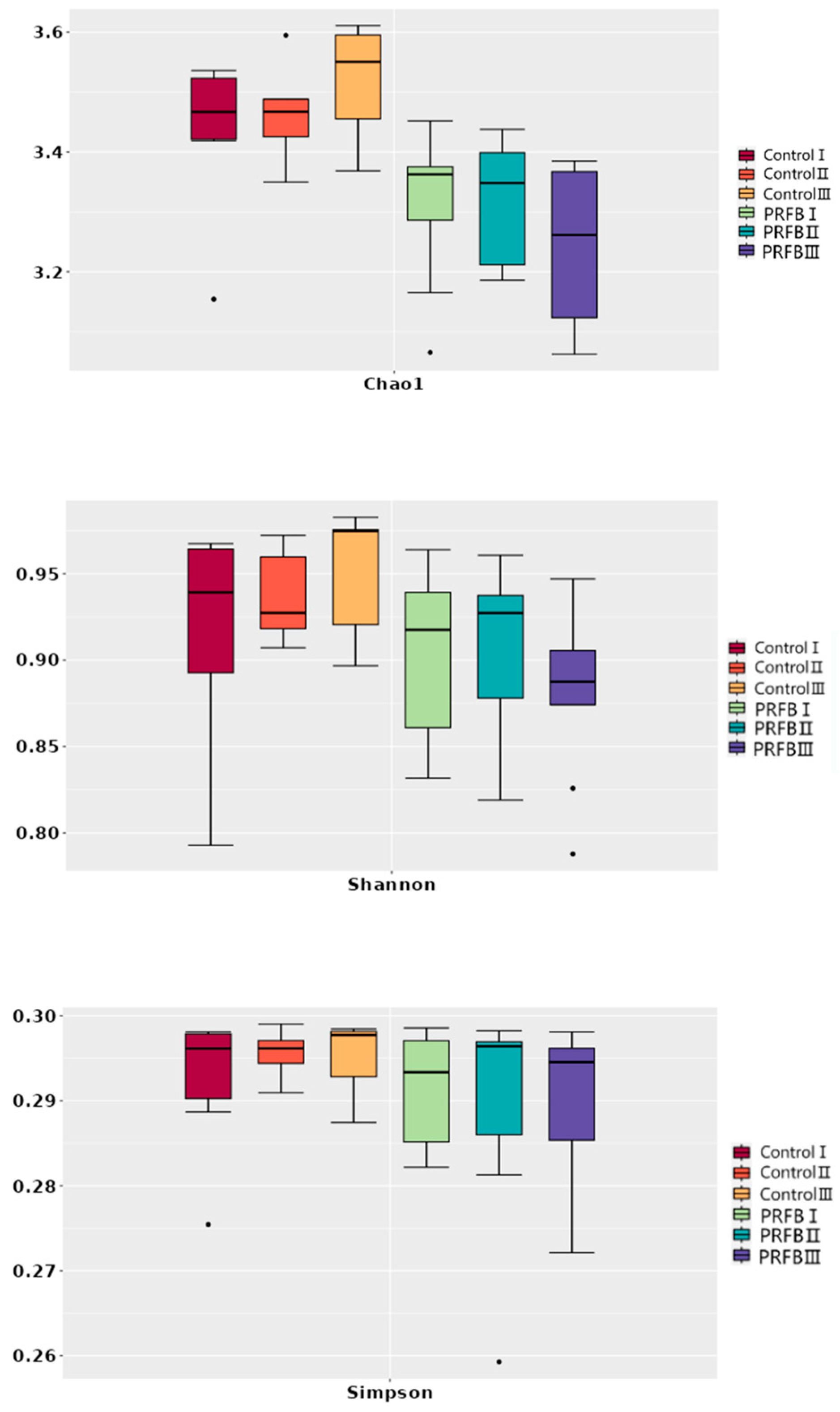
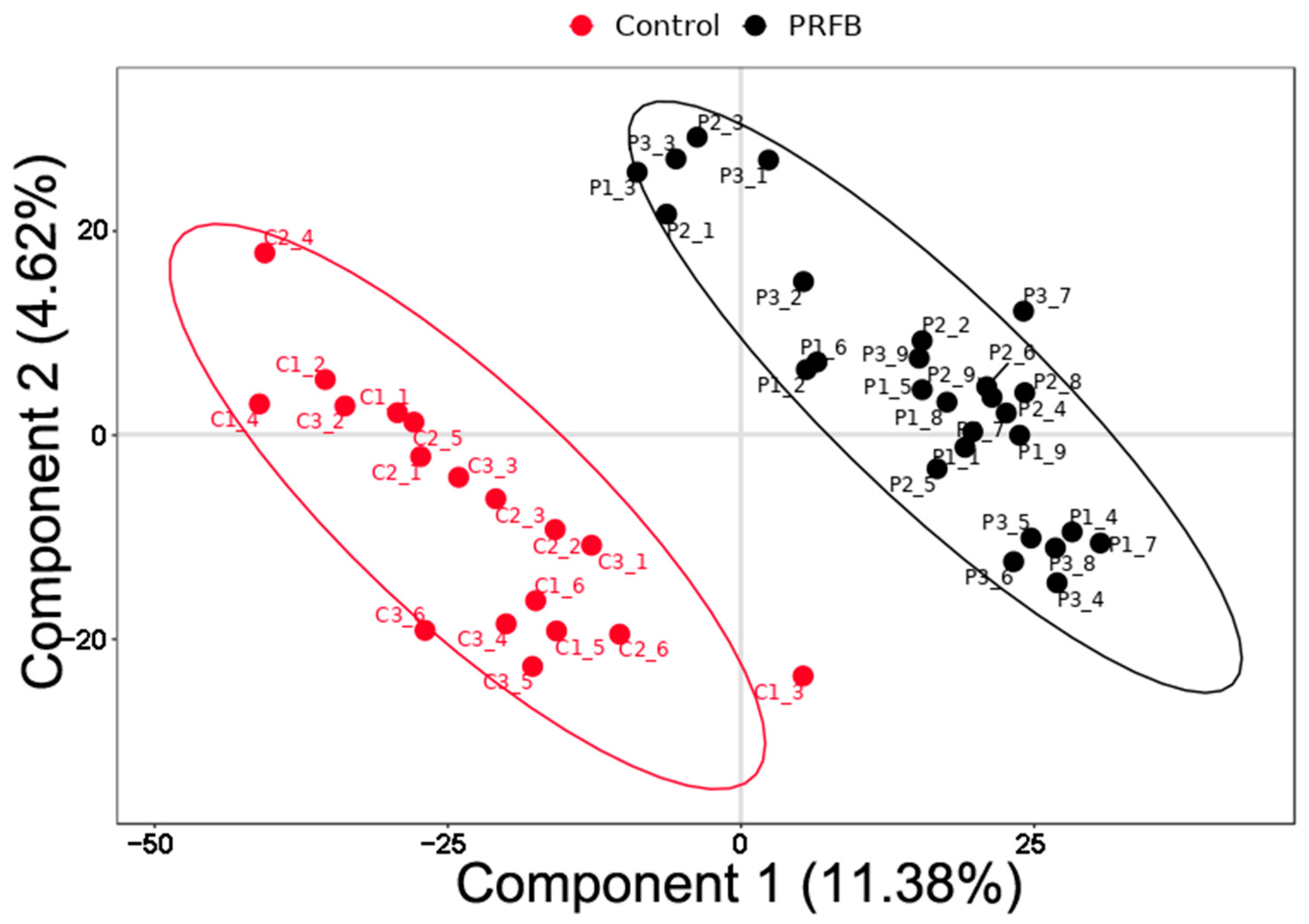
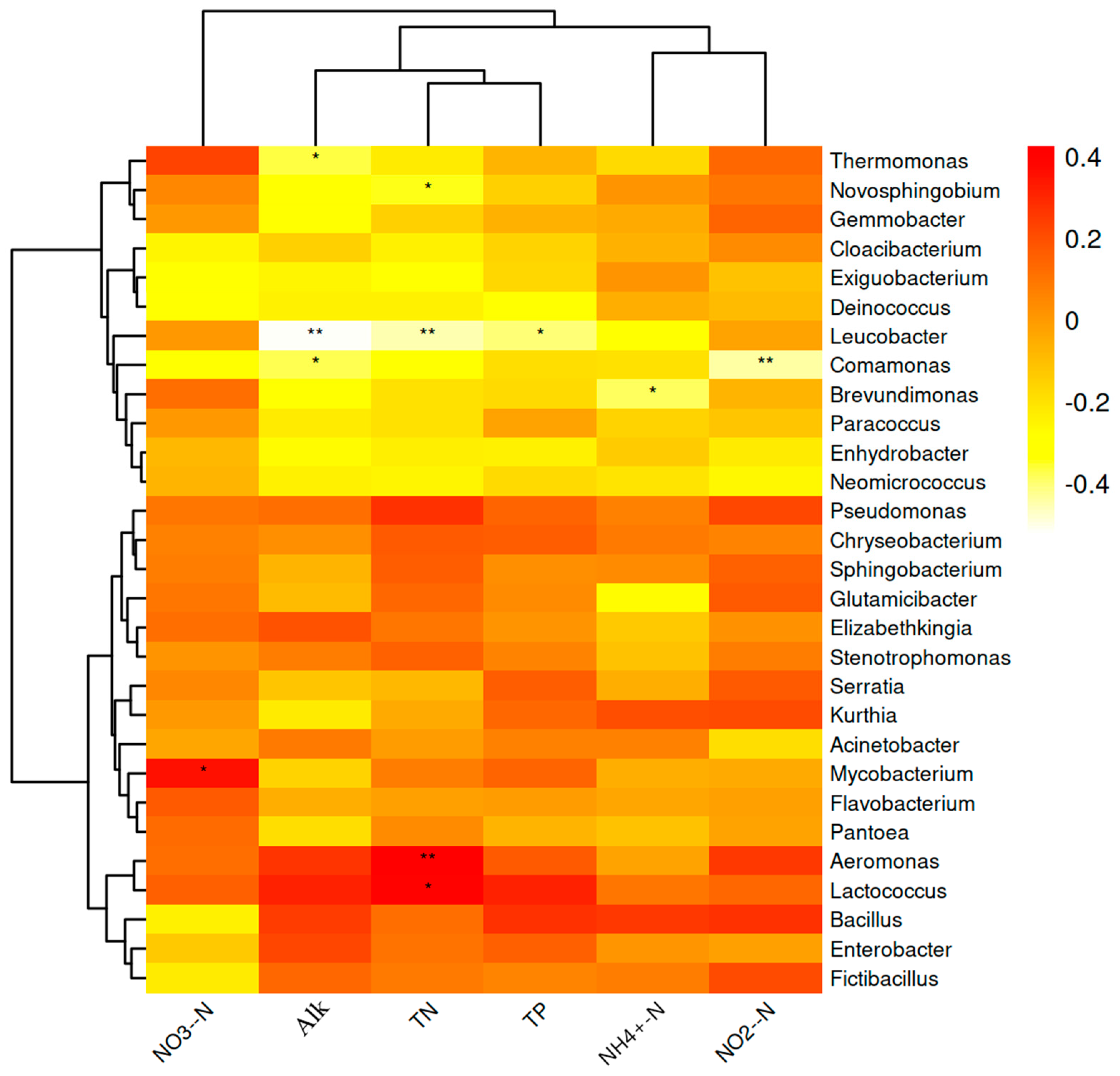
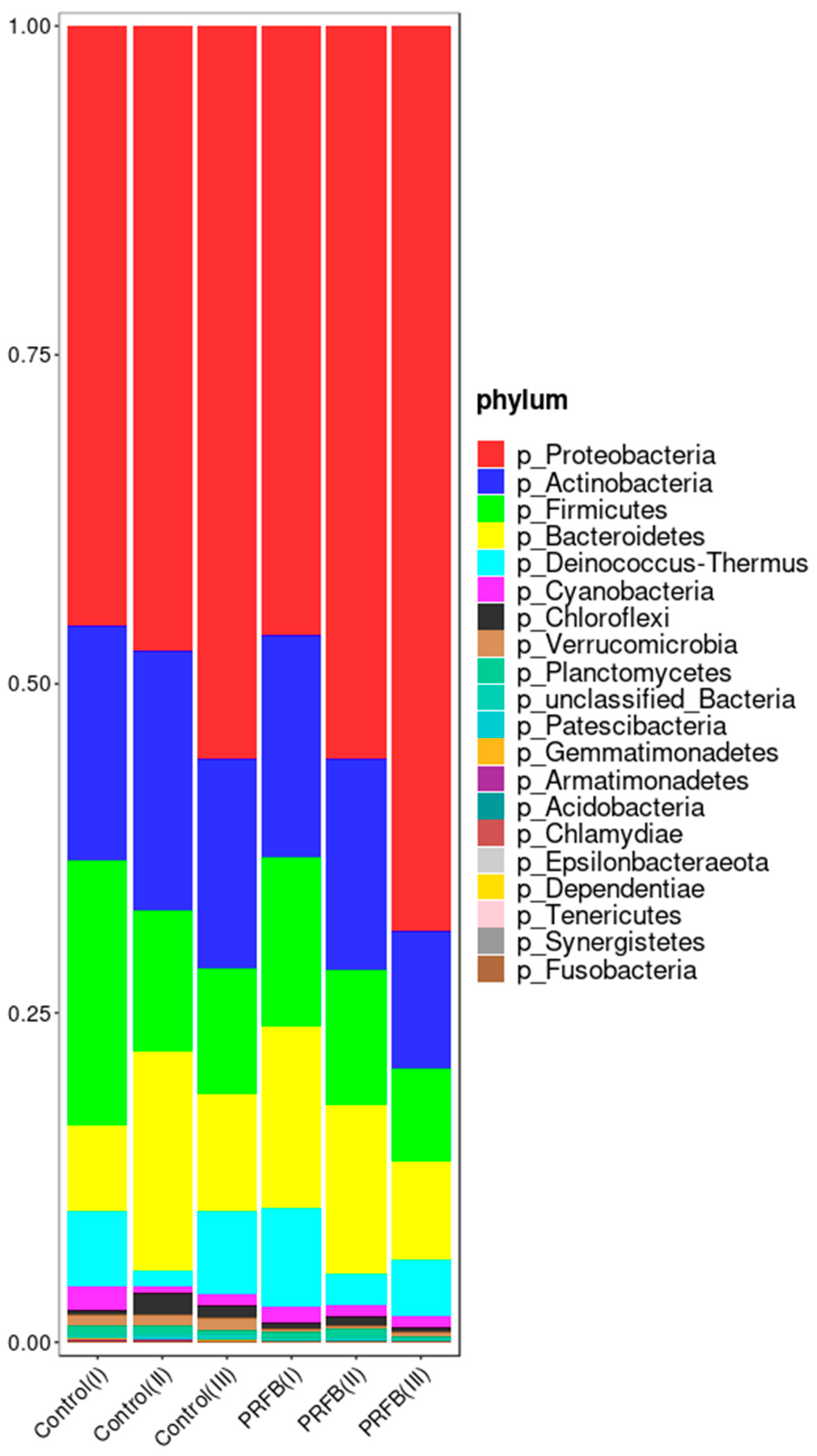
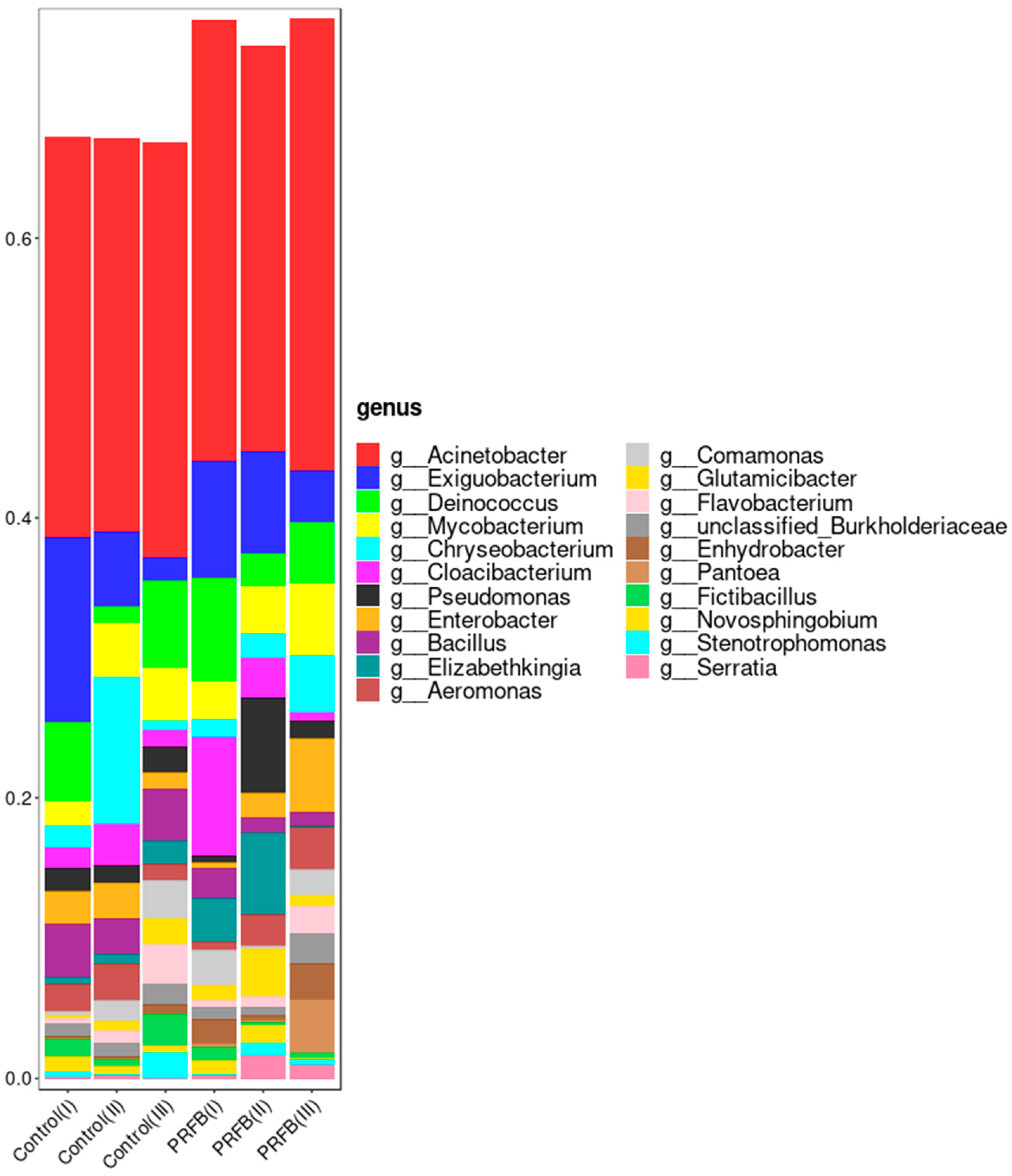

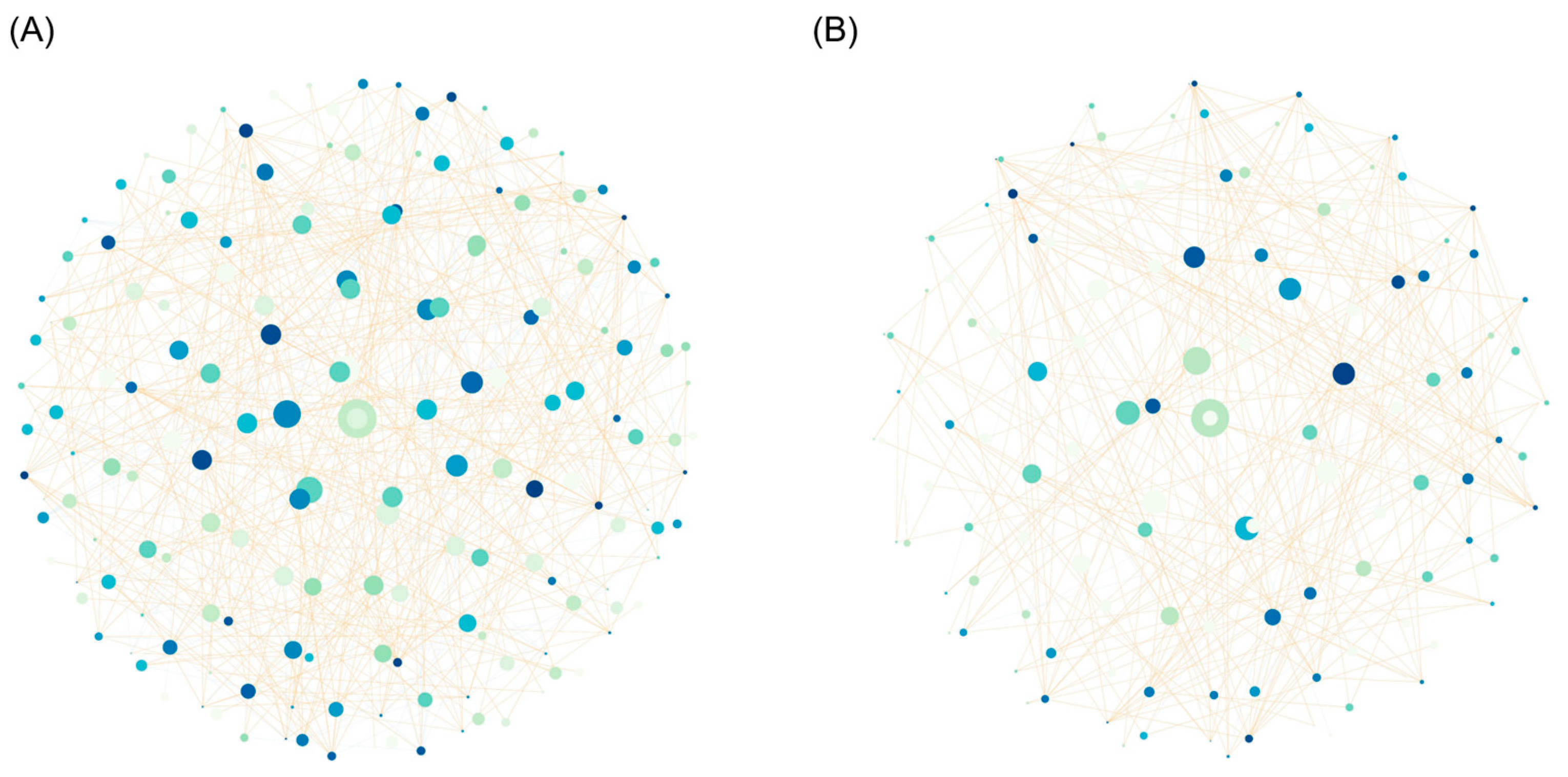

| Groups | Pond Number | Pond Area (hm2) | Density (Tail/hm2) | Rice Planting Area |
|---|---|---|---|---|
| Control | Control-A | 0.234 | 60,000 | 0 |
| Control-B | 0.330 | 60,000 | 0 | |
| Control-C | 0.310 | 60,000 | 0 | |
| PRFB | PRFB-A | 0.240 | 60,000 | 30% |
| PRFB-B | 0.415 | 60,000 | 30% | |
| PRFB-C | 0.330 | 60,000 | 30% |
| Water Quality Parameters | Alk | NH4+-N | NO2−-N | NO3−-N | TN | TP |
|---|---|---|---|---|---|---|
| Concentration (mg/L) | 107.99 | 0.365 | 0.0225 | 0.024 | 1.508 | 0.425 |
| Water Quality Parameters | Test Method |
|---|---|
| Alkalinity | pH indicator titration |
| NH4+-N | Nessler’s reagent colorimetric method |
| NO2−-N | N-(1-naphthyl) ethylenediamine photometric method |
| NO3−-N | Phenol sulfonic acid spectrophotometry |
| TN | Potassium persulfate ultraviolet spectrophotometry |
| TP | Malachite green phosphomolybdate heteropoly metalate spectrophotometry |
Disclaimer/Publisher’s Note: The statements, opinions and data contained in all publications are solely those of the individual author(s) and contributor(s) and not of MDPI and/or the editor(s). MDPI and/or the editor(s) disclaim responsibility for any injury to people or property resulting from any ideas, methods, instructions or products referred to in the content. |
© 2024 by the authors. Licensee MDPI, Basel, Switzerland. This article is an open access article distributed under the terms and conditions of the Creative Commons Attribution (CC BY) license (https://creativecommons.org/licenses/by/4.0/).
Share and Cite
Jiang, L.; Yi, M.; Jiang, Z.; Wu, Y.; Cao, J.; Liu, Z.; Wang, Z.; Lu, M.; Ke, X.; Wang, M. Effect of Pond-Based Rice Floating Bed on the Microbial Community Structure and Quality of Water in Pond of Mandarin Fish Fed Using Artificial Diet. Biology 2024, 13, 549. https://doi.org/10.3390/biology13070549
Jiang L, Yi M, Jiang Z, Wu Y, Cao J, Liu Z, Wang Z, Lu M, Ke X, Wang M. Effect of Pond-Based Rice Floating Bed on the Microbial Community Structure and Quality of Water in Pond of Mandarin Fish Fed Using Artificial Diet. Biology. 2024; 13(7):549. https://doi.org/10.3390/biology13070549
Chicago/Turabian StyleJiang, Lijin, Mengmeng Yi, Zhiyong Jiang, Yuli Wu, Jianmeng Cao, Zhigang Liu, Zhang Wang, Maixin Lu, Xiaoli Ke, and Miao Wang. 2024. "Effect of Pond-Based Rice Floating Bed on the Microbial Community Structure and Quality of Water in Pond of Mandarin Fish Fed Using Artificial Diet" Biology 13, no. 7: 549. https://doi.org/10.3390/biology13070549






